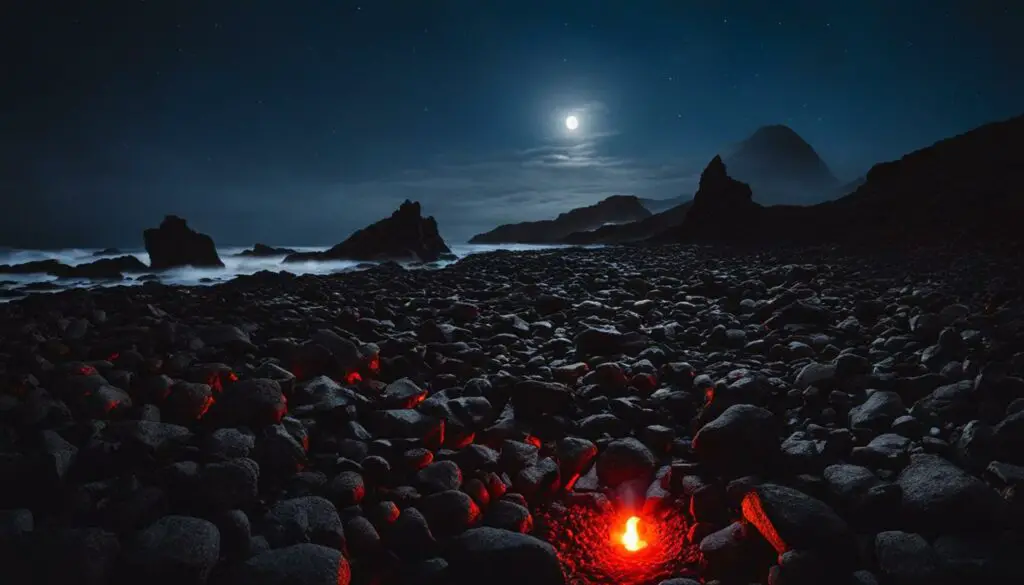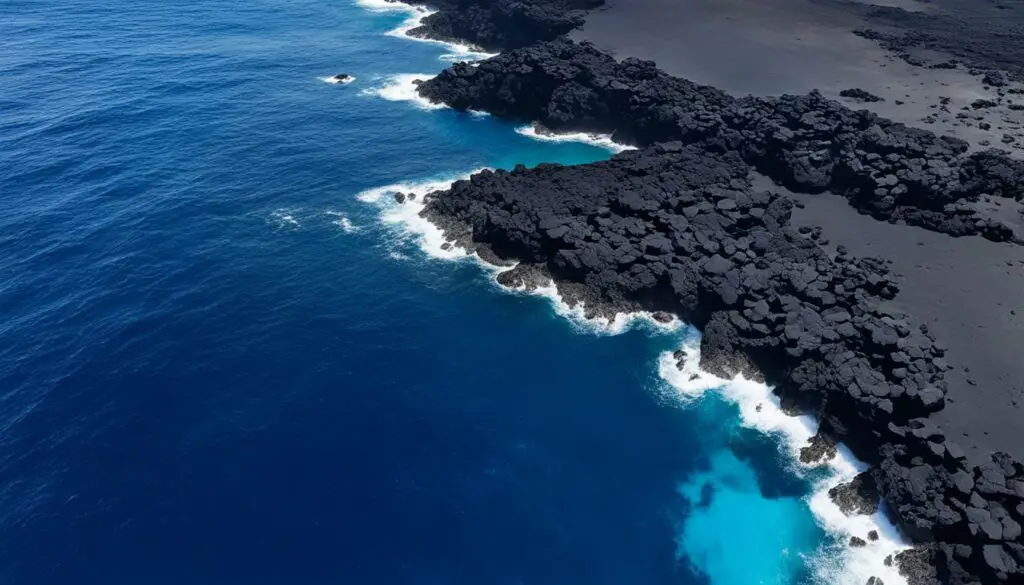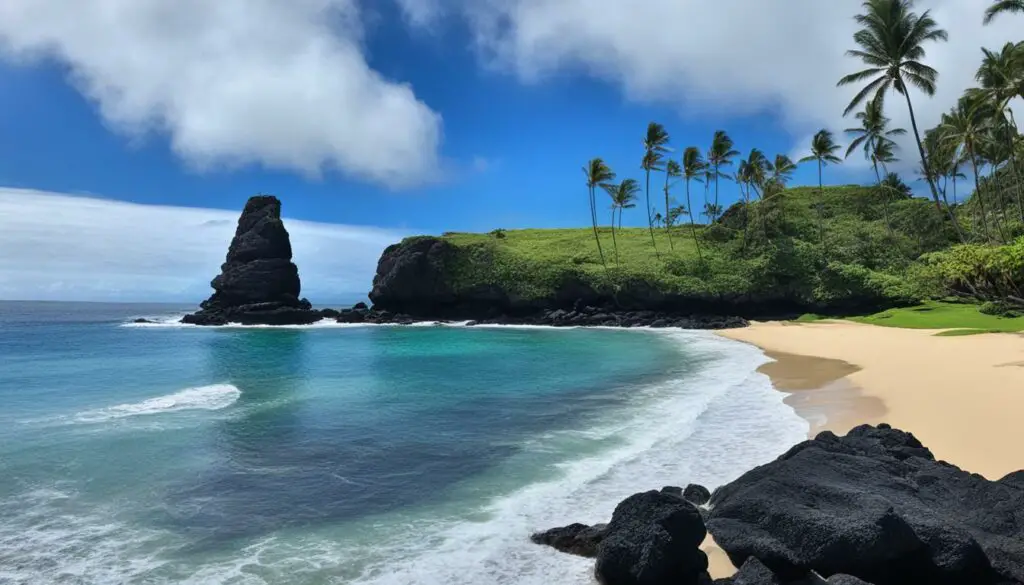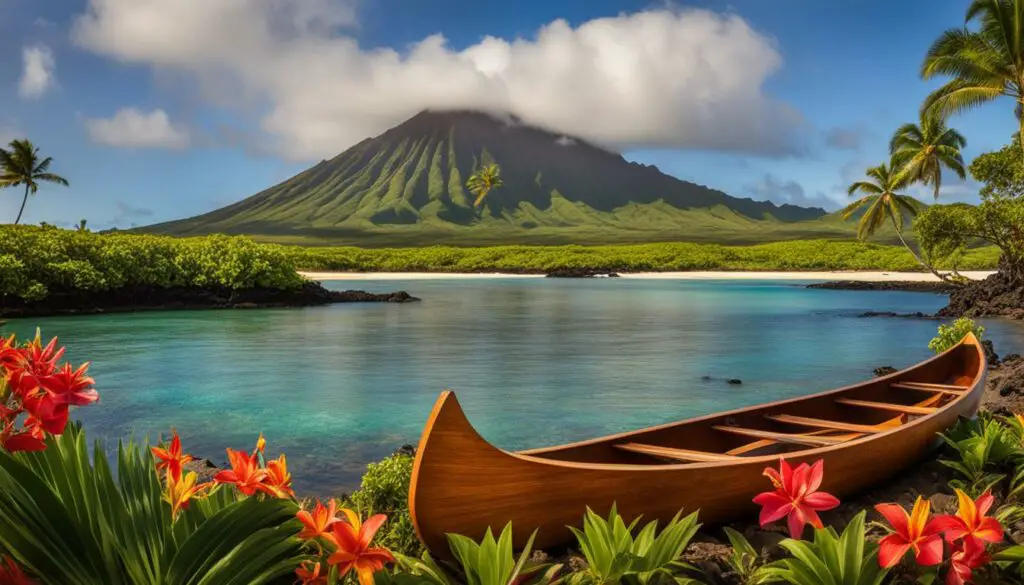Originally posted on January 9, 2024 @ 5:47 am
Have you ever wondered if it’s bad luck to take rocks from Hawaii? In Hawaiian culture, there are strong beliefs and superstitions surrounding the collection of rocks from the islands. These cultural taboos and traditions have been passed down through generations, emphasizing the spiritual significance and respect for the Hawaiian environment. In this article, we will explore the consequences of taking rocks from Hawaii, the legend of Pele’s Curse, and the importance of preserving Hawaiian heritage.
Key Takeaways:
- Taking lava rocks from Hawaii is considered bad luck and is deeply rooted in Hawaiian culture.
- Removing rocks from the islands is not only illegal but also disrespectful to the spiritual significance they hold.
- By leaving rocks in their natural habitat, visitors can contribute to the preservation of Hawaiian culture and protect the environment.
- Understanding and respecting Hawaiian beliefs is essential for responsible tourism and a meaningful visit to the islands.
- Returning “stolen” rocks to Hawaii symbolizes respect for the culture and may bring a sense of closure for those who believe in Pele’s Curse.
The Illegal Status of Taking Lava Rocks

Taking lava rocks from Hawaii is illegal due to the fact that they are a protected natural resource. Lava rocks are formed from the cooled lava that flows from volcanoes and can be found in various places across the Hawaiian islands. These rocks are often used for construction purposes and as decorative elements in gardens. Removing them without proper permission is viewed as theft and is punishable by law.
These lava rocks are considered a protected natural resource in Hawaii, meaning it is illegal to take them without proper authorization. The islands’ volcanic activity creates a unique and fragile ecosystem, making the preservation of lava rocks crucial to maintaining the natural balance.
Protecting a Protected Natural Resource
Due to the volcanic nature of the islands, Hawaii’s landscape is rich in lava rocks that have significant ecological and cultural value. Removing these rocks can have damaging effects on the environment and disrupt the delicate balance of the ecosystem.
Furthermore, lava rocks hold great cultural and spiritual significance in Hawaiian traditions. Considered a sacred representation of the fire goddess Pele, these rocks are deeply ingrained in the Hawaiian culture and are treated with respect and reverence. Taking them without permission is not only a violation of the law but also a disregard for the cultural heritage of the Hawaiian people.
Punishment for Violating the Law
Those caught taking lava rocks from Hawaii without proper authorization can face legal consequences. The punishment for taking rocks from Hawaii can range from fines to imprisonment, depending on the severity of the offense. Additionally, individuals found guilty of this crime may face further penalties, such as restitution or community service.
Preserving Hawaii’s Natural Beauty
Protecting the natural resources of Hawaii, including lava rocks, is essential for preserving its unique and breathtaking beauty. These rocks contribute to the vibrant landscapes and serve as a vital habitat for native plants and animals.
By respecting the laws and regulations that prohibit the taking of lava rocks, visitors can contribute to the conservation efforts and ensure that future generations can continue to enjoy the awe-inspiring beauty of Hawaii’s volcanic landscapes.
The Legend of Pele’s Curse
According to Hawaiian legend, Pele’s Curse is a captivating tale deeply intertwined with the spiritual beliefs of the island’s inhabitants. The legend revolves around Pele, the powerful goddess of fire and volcanoes in Hawaiian mythology.
As the story goes, Pele became furious when a visitor took one of her precious lava rocks as a souvenir. To avenge this act of disrespect and theft, Pele placed a curse on the rock, ensuring that anyone who took it would suffer from bad luck and misfortune.
While there is no definitive scientific evidence to substantiate the existence of Pele’s Curse, its legend has endured for generations, becoming an integral part of the rich cultural heritage of Hawaii. Many locals and visitors alike believe in the curse’s power and strongly discourage taking lava rocks from the islands.
Pele’s Curse is a cautionary tale, reminding us to respect the Hawaiian traditions and the profound spiritual significance of lava rocks. By honoring the legends and beliefs of this beautiful land, we can ensure a meaningful and respectful visit to the islands.
To better understand the cultural and spiritual significance of Pele’s Curse, let us delve deeper into the legend of Pele and her connection to the sacred lava rocks of Hawaii.
Significance and Uses of Lava Rocks

Lava rocks hold immense cultural and spiritual significance in Hawaii. They are considered sacred and are believed to represent the fire goddess Pele. The unique appearance of lava rocks, with their black, smooth surface and jagged edges, adds to their allure.
Aside from their spiritual importance, lava rocks have practical uses as well. They are commonly used in landscaping to create eye-catching features such as rock gardens, pathways, and water features. The contrasting textures and colors of lava rocks can enhance the overall aesthetic appeal of outdoor spaces.
Furthermore, lava rocks have been utilized as building materials in Hawaii for centuries. Their strength and durability make them suitable for constructing walls, foundations, and even entire structures. The incorporation of lava rocks in architecture not only showcases the rich cultural heritage but also reflects the island’s geological history.
Decorating with Lava Rocks
Lava rocks can also add a touch of natural beauty and elegance to interior spaces. Many people use them as decorative elements in their homes, incorporating them into tabletop displays, vases, or as accents in aquariums. The unique textures and earthy tones of lava rocks create a visually appealing contrast with other materials.
“The significance of lava rocks in Hawaii goes beyond their physical properties. They are a symbol of the deep connection between the Hawaiian people and their land.” – Kailani, Hawaiian cultural expert
Spiritual Significance
For Hawaiians, lava rocks hold deep spiritual significance. They are believed to possess mana, a life force or spiritual energy. Many Hawaiians consider them as physical manifestations of the powerful goddess Pele. Lava rocks are often used in spiritual practices, including healing rituals, prayers, and offerings, to honor and connect with the spiritual world.
Whether used for landscaping, construction, or spiritual practices, lava rocks play a vital role in preserving Hawaiian culture and traditions. They serve as a tangible link to the island’s volcanic past and embody the resilience and beauty of the Hawaiian people.
Environmental Preservation and Respect for Hawaiian Tradition
When visiting the beautiful islands of Hawaii, it is crucial to uphold and respect the rich Hawaiian culture and traditions. Part of this respect involves preserving the environment and leaving the natural elements, such as lava rocks, untouched. By doing so, visitors can make a positive contribution to both the cultural heritage and the natural beauty of Hawaii.
Hawaiians have a deep connection with their environment and believe in the spiritual significance of rocks. These lava rocks not only represent the elemental power of fire goddess Pele but also play a vital role in the island’s ecosystem. They provide habitat for rare and unique plants and animals, contributing to the delicate balance of Hawaii’s biodiversity.
By leaving lava rocks in their natural habitat, visitors show reverence for Hawaiian culture and demonstrate responsible tourism. It is a way to honor the spiritual beliefs and traditions held by the Hawaiian people. Respecting these beliefs means contributing to the preservation of Hawaiian heritage and maintaining the integrity of the islands’ natural environment.
“Leaving lava rocks in their natural habitat is a way to honor Hawaiian culture and protect the environment.”
Furthermore, leaving rocks in Hawaii also ensures the sustainability of the islands’ beauty for future generations. The natural landscapes of Hawaii, including its rugged coastlines and volcanic landscapes, are unique and awe-inspiring. Preserving these natural wonders by refraining from taking rocks as souvenirs allows others to experience the same sense of wonder and appreciation for Hawaii’s natural splendor.
| Benefits of Leaving Rocks in Hawaii | Environmental Preservation | Cultural Respect |
|---|---|---|
| Preserves the delicate ecosystem | ✓ | |
| Maintains biodiversity | ✓ | |
| Promotes responsible tourism | ✓ | ✓ |
| Sustains the natural beauty for future generations | ✓ |
The Consequences of Taking Rocks from Hawaii

Many people who have taken lava rocks from Hawaii have reported experiencing a string of bad luck and misfortune. These range from lost luggage to missed flights, accidents, and other unfortunate incidents. While these experiences cannot be scientifically proven to be directly caused by taking rocks, the belief in Pele’s Curse and the cultural significance of the rocks make it a cautionary tale for visitors.
Examples of Bad Luck from Taking Rocks
- One tourist who took a lava rock from a beach in Hawaii found themselves in a series of car accidents and experienced multiple vehicle breakdowns in the following weeks.
- A couple who brought home lava rocks as souvenirs reported a streak of financial difficulties, including unexpected expenses and job loss.
- A hiker who pocketed a lava rock from a volcano trail encountered a series of health issues and accidents.
- Another visitor who took a lava rock from an ancient lava field experienced a series of relationship problems and personal setbacks.
While these incidents may seem coincidental, they serve as cautionary tales about the potential consequences of taking rocks from Hawaii. Whether attributed to Pele’s Curse or simply a matter of respect for Hawaiian culture and traditions, it is best to leave the lava rocks where they belong – on the islands.
Understanding Hawaiian Beliefs

Hawaiians have a deep spiritual connection to their environment, including rocks. They believe in the concept of “mana,” which is the life force or spiritual essence that resides in all living and non-living things. Rocks are seen as having their own mana and are treated with reverence. Taking rocks without following the proper protocols or ceremonies is considered culturally inappropriate and disrespectful.
In Hawaiian culture, rocks hold significant spiritual and cultural value. They are believed to carry the energy and wisdom of the land, ancestors, and deities. Rocks are considered a tangible manifestation of the divine and are regarded as sacred objects. Hawaiians respect and honor rocks as part of their deep-rooted spiritual traditions.
Spirituality in Hawaii is deeply intertwined with the natural world. The islands are seen as living entities with their own spiritual essence. Hawaiians believe in the interconnectedness of all things and emphasize the importance of maintaining a harmonious relationship with nature. This deep respect for nature is reflected in their beliefs about rocks and the cultural taboos surrounding their removal.
“In Hawaiian culture, rocks are seen as part of the spiritual realm, carrying the stories, energy, and mana of the land. It is essential to treat rocks with reverence and respect, ensuring the preservation of Hawaiian traditions and the protection of the environment.”
The Cultural Taboos in Hawaii
Hawaiian culture is built on a foundation of respect for nature and the spiritual significance of the land. There are cultural taboos (known as “kapu”) regarding the handling and removal of rocks. These taboos serve as guidelines to maintain the balance and harmony between humans, nature, and the spiritual realm.
One of the cultural taboos in Hawaii is the prohibition of taking rocks from sacred sites and natural areas without proper permission and guidance. These sites hold deep cultural and historical significance and are considered the dwelling places of deities and ancestors. Disregarding these limitations is not only disrespectful but also disrupts the spiritual equilibrium cherished by the Hawaiian people.
Another important cultural taboo is the belief that taking rocks from certain areas can disrupt the natural flow of energy and mana. It is believed that removing rocks from their designated places can disturb the delicate balance and cause negative consequences for the individual responsible and the surrounding environment.
Hawaiian Respect for Nature
Hawaii is known for its breathtaking natural beauty, and Hawaiians have a profound respect for the environment. They strive to live in harmony with nature and promote sustainable practices that prioritize the preservation of the land, oceans, and wildlife.
Hawaiians see themselves as stewards of the land and hold a responsibility to protect and care for it. This includes acknowledging the inherent value of rocks and their role in the ecosystem. Rocks provide homes for unique flora and fauna and contribute to the overall balance of the environment.
By respecting Hawaiian beliefs about rocks and embracing the spirituality and cultural taboos, visitors to Hawaii can contribute to the preservation of the natural beauty and heritage of the islands. They can engage in responsible tourism by leaving rocks undisturbed and appreciating the inherent mana that resides within them.
Debunking Myths Surrounding Pele’s Curse

Despite the widespread belief in Pele’s Curse, there are various speculations surrounding its origin and authenticity. Some suggest that it was a myth created by frustrated park rangers in the 1940s to discourage tourists from taking rocks. Others believe it may have been fabricated by tired bus drivers who wanted to prevent passengers from carrying rocks onto their buses. While the exact origin of the curse remains unclear, it is important to note that Hawaiian beliefs and cultural taboos regarding rocks existed long before the curse gained popularity.
While Pele’s Curse may have captured the imagination of many, it is crucial to separate fact from fiction. Hawaiian culture has a deep reverence for the environment, including rocks, which are believed to possess their own spiritual energy or mana. This respect for natural resources and recognition of their significance predates any notion of a curse associated with taking rocks from Hawaii.
It is worth noting that perception and belief can shape people’s experiences, contributing to the notion that Pele’s Curse is real. However, no scientific evidence substantiates the existence of a supernatural curse tied to these rocks. The misfortune that some individuals attribute to the curse may be coincidental or a result of psychological suggestion rather than an actual consequence of taking the rocks.
“There is no evidence to support the idea that taking lava rocks from Hawaii brings bad luck. It is more likely a cultural belief or superstition that has been perpetuated over time.” – Dr. Leilani Ruff, Cultural Anthropologist
While it is essential to respect Hawaiian beliefs and cultural traditions, it is equally important to approach the notion of Pele’s Curse with an open mind. By understanding the historical context, cultural significance, and taking into account alternative explanations, visitors can appreciate the rich heritage of the Hawaiian people without being weighed down by unfounded fears.
Debunking Speculations
Speculations on the origin of Pele’s Curse include:
- Myth created by frustrated park rangers in the 1940s
- Creation by tired bus drivers to prevent passengers from carrying rocks onto their buses
| Origin Speculation | Credibility |
|---|---|
| Curse invented by park rangers | Unverified and likely fabricated |
| Curse created by bus drivers | Unsubstantiated and lacks evidence |
Importance of Hawaiian Heritage and Adhering to Traditions

Whether Pele’s Curse is believed to be real or not, it is essential to understand and respect Hawaiian heritage and traditions. The Hawaiian people have a deep connection to their environment and believe that everything, including rocks, possesses a life force called mana. They view themselves as part of their environment and treat all elements with utmost respect.
Hawaiian heritage is rich with cultural beliefs and traditions that have been passed down through generations. These traditions emphasize the importance of treating natural resources, such as lava rocks, with reverence. The rocks, believed to hold spiritual significance, are deeply intertwined with Hawaiian culture and are considered sacred.
“In Hawaiian culture, we believe that the rocks, the plants, and the animals are all our relatives. We have a responsibility to care for them and to treat them with respect and gratitude.” – Kekai Kapu, Native Hawaiian Cultural Practitioner
By adhering to Hawaiian traditions and treating natural resources appropriately, visitors can contribute to the preservation of Hawaiian culture and the protection of the islands’ beauty. This includes refraining from taking lava rocks as souvenirs and instead appreciating them in their natural habitat. Leaving the rocks untouched allows them to continue playing their role in the ecosystem, providing habitat for rare plants and animals.
Respecting Hawaiian Traditions
Respecting Hawaiian traditions goes beyond simply following rules or laws. It involves immersing oneself in the cultural values and understanding the deep spiritual connection that Hawaiians have with their environment. It means approaching the islands with humility, gratitude, and a willingness to learn from the local community.
Here are a few ways visitors can respect Hawaiian traditions:
- Learn about the history and culture of Hawaii before your visit. Familiarize yourself with the customs, beliefs, and practices of the Hawaiian people.
- Seek permission before entering sacred sites or engaging in activities that hold cultural significance.
- Support local businesses and artisans, purchasing souvenirs that are respectful of Hawaiian culture.
- Observe and follow any guidelines or instructions provided by local authorities or cultural practitioners.
- Engage in responsible tourism practices, such as minimizing waste, conserving water, and respecting wildlife.
By respecting Hawaiian heritage and adhering to traditions, visitors can experience a more meaningful and authentic connection to the islands, while also contributing to the preservation of Hawaiian culture for future generations to appreciate and cherish.
Travel Tips for Visitors to Hawaii
When planning a trip to Hawaii, it’s essential to be a responsible tourist and respect the local culture and environment. Here are some travel tips to help you make the most of your visit:
Educate Yourself
Before your trip, take some time to learn about Hawaiian traditions and customs. Understanding the cultural significance of lava rocks and the belief in Pele’s Curse will enable you to navigate the islands respectfully.
Leave Rocks Behind
Responsible tourism in Hawaii means refraining from taking lava rocks as souvenirs. Instead, consider leaving the rocks where they belong and taking photographs to capture your memories. Appreciating their natural beauty without removing them shows respect for the environment and Hawaiian culture.
Support Local Artisans
When looking for souvenirs, opt for locally made products that showcase Hawaiian craftsmanship and cultural heritage. By purchasing items such as traditional crafts or locally produced goods, you can support the local economy and contribute to the preservation of Hawaiian traditions.
Embrace Sustainable Practices
Practice responsible tourism by being mindful of your environmental impact. Reduce plastic waste by using reusable items, dispose of trash properly, and participate in conservation initiatives. By leaving Hawaii in the same beautiful state you found it, you help maintain its natural splendor for future generations.
“Responsible tourism in Hawaii involves respecting the cultural traditions and natural resources of the islands.”
By following these travel tips, you can contribute to responsible tourism in Hawaii and have a memorable and respectful experience. Remember, leaving rocks behind, supporting local artisans, and embracing sustainable practices are all part of being an eco-conscious traveler.
| Travel Tips for Hawaii | Description |
|---|---|
| Educate Yourself | Learn about Hawaiian traditions and customs. |
| Leave Rocks Behind | Refrain from taking lava rocks as souvenirs. |
| Support Local Artisans | Purchase locally made products to support the local economy. |
| Embrace Sustainable Practices | Reduce plastic waste and practice environmental conservation. |
Returning “Stolen” Items to the Islands
Some people who have taken lava rocks from Hawaii and experienced bad luck may choose to return the rocks in an attempt to break the curse. While it is impossible to determine the exact spot from where the rocks were taken, returning them to the islands symbolizes respect for Hawaiian beliefs and may bring a sense of closure to those who believe in the curse.
Conclusion
Taking lava rocks from Hawaii goes beyond the realm of legality – it is also entwined with beliefs in the infamous Pele’s Curse. These rocks carry immense spiritual significance for the Hawaiians and are considered an integral part of their culture. Regardless of personal beliefs, it is crucial to respect and honor the Hawaiian heritage by treating these rocks and the environment with veneration. By leaving the rocks undisturbed and embracing responsible tourism practices, visitors can actively contribute to the preservation of Hawaiian culture and the safeguarding of the islands’ natural beauty.
In conclusion, while the tangible consequences of taking rocks from Hawaii remain uncertain, the intangible repercussions should not be disregarded. To sustain the cultural traditions and environmental integrity of the islands, it is essential for visitors to refrain from removing lava rocks as souvenirs. Instead, one can partake in a deeper appreciation of Hawaiian culture by learning about their customs and opting for respectful mementos that reflect the local heritage. Together, we can uphold the spirit of Hawaii, cherishing its traditions and protecting its breathtaking landscapes.
In the final analysis, by embracing responsible tourism and abiding by the cultural beliefs surrounding the collection of rocks, we can forge meaningful connections with the Hawaiian islands, ensuring that future generations can also experience the wonders and spirituality they hold. Let us explore this enchanting archipelago with reverence, leaving intact the rocks that have enriched the lives and beliefs of the Hawaiian people for centuries.
FAQ
Is taking rocks from Hawaii considered bad luck?
Yes, taking rocks from Hawaii is considered bad luck. It is believed to bring misfortune and is known as Pele’s Curse, deeply rooted in Hawaiian culture.
Is it illegal to take lava rocks from Hawaii?
Yes, taking lava rocks from Hawaii is illegal. They are a protected natural resource, and removing them without proper permission is considered theft and punishable by law.
What is the legend of Pele’s Curse?
Pele’s Curse is a legend in which the goddess Pele placed a curse on anyone who took her lava rocks from Hawaii, resulting in bad luck and misfortune.
What is the significance of lava rocks in Hawaiian culture?
Lava rocks hold spiritual significance and are associated with the fire goddess Pele. They are also used for building materials and as decorative elements in Hawaii.
How can I respect Hawaiian traditions and protect the environment while visiting?
It is important to leave lava rocks in their natural habitat, as they play a role in the ecosystem. By following responsible tourism practices, you contribute to the preservation of Hawaiian culture and the protection of the islands’ beauty.
Are there any consequences of taking rocks from Hawaii?
Many people who have taken rocks from Hawaii have reported experiencing a string of bad luck and misfortune, ranging from lost luggage to accidents. While not scientifically proven, the belief in Pele’s Curse makes it a cautionary tale for visitors.
What are the cultural beliefs regarding rocks in Hawaii?
Hawaiians have a deep spiritual connection to their environment and believe that rocks have their own life force or mana. Taking rocks without following proper protocols is considered culturally inappropriate and disrespectful.
What is the origin of Pele’s Curse?
The exact origin of Pele’s Curse is unclear. Some speculate that it was created by frustrated park rangers or tired bus drivers to discourage tourists from taking rocks. However, Hawaiian beliefs and cultural taboos regarding rocks existed long before the curse became popular.
Why is it important to respect Hawaiian heritage and traditions?
Hawaiians believe that everything in their environment, including rocks, has a life force. By treating natural resources with respect, you honor Hawaiian culture and contribute to the preservation of their traditions.
What travel tips should I keep in mind when visiting Hawaii?
Be a responsible tourist by refraining from taking lava rocks as souvenirs. Instead, consider taking photographs or purchasing locally made souvenirs that respect Hawaiian culture. Educating yourself about Hawaiian traditions and customs is also beneficial.
Should I return the rocks if I have already taken them?
Some people choose to return the rocks in an attempt to break the curse. While it is impossible to determine the exact spot they were taken from, returning them symbolizes respect for Hawaiian beliefs and may bring a sense of closure.
What are the final thoughts on taking rocks from Hawaii?
It is important to understand and respect Hawaiian heritage and traditions. Leaving rocks behind and following responsible tourism practices contribute to the preservation of Hawaiian culture and the protection of the islands’ natural beauty.
